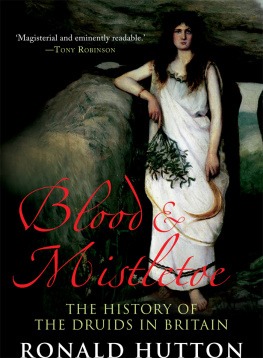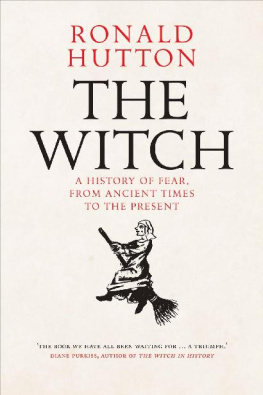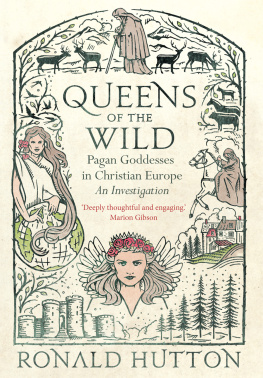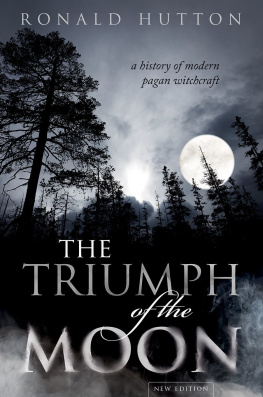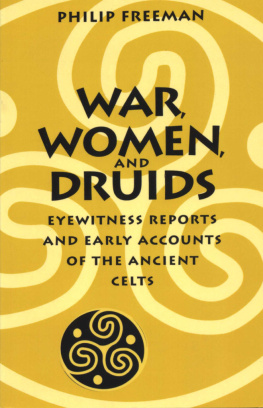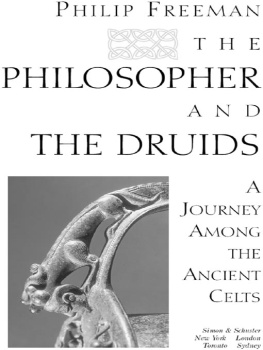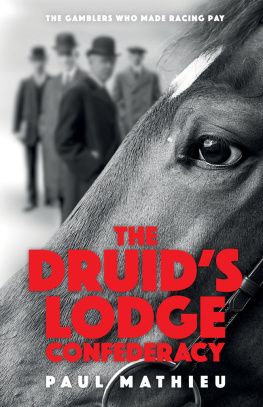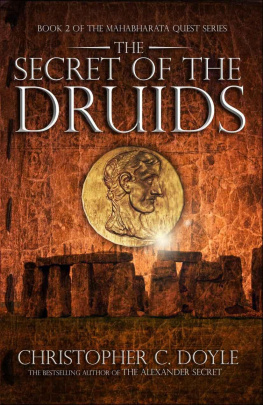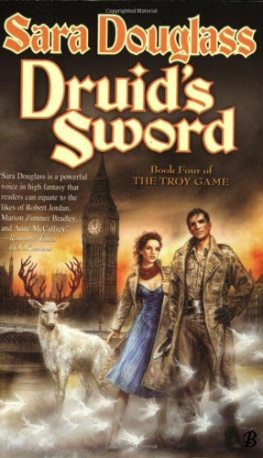BLOOD AND MISTLETOE
R ONALD H UTTON is professor of history, University of Bristol, and the author of many books including, most recently, The Druids, Debates in Stuart History and Witches, Druids, and King Arthur: Studies in Paganism, Myth, and Magic.
BLOOD AND
MISTLETOE
THE HISTORY OF THE
DRUIDS IN BRITAIN
RONALD HUTTON
YALE UNIVERSITY PRESS
NEW HAVEN & LONDON
Copyright 2009 Ronald Hutton
First printed in paperback 2011
All rights reserved. This book may not be reproduced in whole or in part, in any form (beyond that copying permitted by Sections 107 and 108 of the U.S. Copyright Law and except by reviewers for the public press) without written permission from the publishers.
For information about this and other Yale University Press publications, please contact:
U.S. Office:
Europe Office:
Set in Adobe Caslon by IDSUK (DataConnection) Ltd.
Printed in Great Britain by Hobbs the Printer, Totton, Hampshire
Library of Congress Cataloging-in-Publication Data
Hutton, Ronald.
Blood and mistletoe: the history of the Druids in Britain / Ronald Hutton.
p. cm.
Includes bibliographical references and index.
ISBN 978-0-300-14485-7 (ci: alk. paper)
1. Druids and druidismHistory. 2. Great BritainReligion. I. Title.
BL910.H88 2009
299'.160941dc22
2008044642
A catalogue record for this book is available from the British Library.
ISBN 9780300170856 (pbk)
The paper used for the text pages of this book is FSC certified. FSC (The Forest Stewardship Council) is an international network to promote responsible management of the world's forests.
10 9 8 7 6 5 4 3 2 1
CONTENTS
ILLUSTRATIONS

1. Statue of Julius Caesar. National Museum, Naples, Italy. Bettmann/CORBIS.
2. Marble statue of the Roman emperor Tiberius. Found in 1795 in Privernum (Piperno). Vatican Museums, akg-images.
3. Coligny Calendar. Muse de la Civilisation Gallo-Romaine, Lyon. The Art Archive/Gianni Dagli Orti.
4. The Great Torc from Sneyyisham, Norfolk. Buried first century BC . Trustees of the British Museum.
5. Unknown artist, John Aubrey, mezzotint, eighteenth century. National Portrait Gallery, London.
6. The Avebury Circles, drawing from John Aubrey's unpublished Monumenta Britannica, created 166593. Bodleian Library, Oxford.
7. William Stukeley, Self-Portrait as a Druid, 1740. University of Bristol Library special collections.
8. William Stukeley, Stonehenge, drawing, 1740. University of Bristol Library special collections.
9. William Stukeley, Reconstruction of the Avebury Complex Showing a Druidical Sacrifice, 1759. Bodleian Library, Oxford
10. Nathaniel Whittock, Druids Sacrificing to the Sun in their Temple called Stonehenge, lithograph, 19023. Salisbury & South Wiltshire Museum.
11. Grand Conventional Festival of Britons at Stonehenge from Samuel Rush Meyrick and Charles Hamilton Smith, Costume of the Original Inhabitants of the British Isles (London, Howlett & Brimmer, 1815). The Art Archive.
12. Unknown artist, An Archdruid, c. 17621816 from Samuel Rush Meyrick and Charles Hamilton Smith, Costume of the Original Inhabitants of the British Isles (London, Howlett & Brimmer, 1815). The Art Archive.
13. Sparrow, Pliny's Image of the Druid as a Gatherer of Mistletoe, engraving, 19023, illustration for William Mason's Caractacus. Salisbury & South Wiltshire Museum.
14. S. F. Ravenet, The Druids; or the Conversion of the Britons to Christianity, engraving, 1752, after F. Hayman. Wellcome Library, London.
15. Noah's Ark During the Flood, fresco, c. 1100. Abbey Church, Saint-Savin-sur-Gartempe, France. Lauros/Giraudon/Bridgeman Art Library.
16. The Wicker Image of the Druid from Aylett Sammes, Britannia Antiqua Illustrata, 1676. The Art Archive.
17. R. Mills, The Treasurer of the Grand Lodge of Druids, engraving, 1832, frontispiece from the Druids' Magazine. Wellcome Library, London.
18. A Sketch of the Grand Lodge as it Appeared on 1 March 1832, engraving, 1832. Wellcome Library, London.
19. Procession of Salisbury Lodge of Druids, 27 June 1832. Salisbury & South Wiltshire Museum.
20. Robert Cruickshank, Iolo Morganwg, c. 1875. The National Library, Wales.
21. John Martin, The Bard, oil on canvas, c. 1817. Yale Center for British Art, Paul Mellon Collection, New Haven.
22. William Blake, The Voice of the Ancient Bard, plate 31 from Songs of Innocence, 1789, relief etching with watercolour. Yale Center for British Art, Paul Mellon Collection, New Haven.
23. W. O. Gellers, The Druids' Sacrifice, engraving, 1832. Salisbury & South Wiltshire Museum.
24. Benjamin Robert Haydon, William Wordsworth, oil on canvas, 1842. National Portrait Gallery, London. Giraudon/Bridgeman Art Library.
25. Frontispiece of William Kingston's Eldol the Druid, 1874. Fortean Picture Library.
26. Gaetano Zancon, An Indian Widow Burns to Death with her Husband's Body, coloured engraving, nineteenth century. Private collection. Stapleton Collection/Bridgeman Art Library.
27. Hindu Goddess Kali Dancing on Siva, colour lithograph. Private collection. Archives Charmet/Bridgeman Art Library.
28. The Rocking Stone on Pontypridd Common. Author's photograph.
29. Dr William Price in Ceremonial Costume, lithograph, nineteenth century. National Museum Wales.
30. The Ancient Order of the Druids ceremony at Stonehenge. Salisbury & South Wiltshire Museum.
31. Head of the stone serpent avenue on Pontypridd Common. Author's photograph.
32. Title page of the official magazine of the Ancient Order of Druids, 1909.
33. Robert MacGregor-Reid, Chosen Chief of the Druid Order, during the ceremony to mark the Autumnal Equinox of the Sun on Primrose Hill, London, 23 September 1957. Keystone/Getty Images.
34. Stonehenge, the Dawn Ceremony on the summer solstice, 21 June 1956. Photo by Harry Kerr/BIPs/Getty Images.
35. Scene at a Welsh National Eisteddfod. Popperfoto/Getty Images.
36. Chief Druid Dr Thomas Maughan, Tower Hill, 1966. Fox Photos/Getty Images.
37. Gorsedd' Druid meeting in Hanvec, 18 July 1999. Annebicque Bernard/Corbis Sygma.
ACKNOWLEDGEMENTS
A s the work on which this book is based was the same as that carried out for its predecessor, The Druids, my debts of gratitude are the same; but they are so great that they need to be repeated. Many specific kindnesses are recorded in the notes to the book; so only the overarching group is acknowledged here. The Arts and Humanities Research Council provided most of the funding for my research, and with it an assistant, Dr Joanne Parker, who was a wonderful partner and has launched her own very promising career, presently at Exeter University, on the strength of it. My department at Bristol welcomed Joanne and gave me a year of reduced teaching in which to complete the project. The Order of Bards, Ovates and Druids functioned as a research council in its own right, both collectively and in the person of its present Chosen Chief, Philip Carr-Gomm. He bestowed a grant for the preliminary research, and lent me books and sent me photocopied documents from his order's own archive and library, built up by him patiently over many years of collecting.
I am also grateful to the staff of the many public libraries and archives that I have visited in the course of the project; they were almost invariably kind and helpful. Once more I single out for special mention those of the Wiltshire Archaeological and Natural History Society Library; the Salisbury and South Wiltshire Museum; Cardiff University Library's Salisbury Collection (especially Peter Keelan); and Hywel Matthews at Pontypridd Public Library. To this list of heroes and heroines I would here add another: John Goodchild, owner and custodian of the remarkable collection of materials relating to friendly societies that is housed underneath Wakefield Public Library. He welcomed me and supplied documents for me with marvellous care and interest. When I offered to buy him lunch as a return for his efforts, he refused it simply to disprove the saying that nobody ever gets anything for nothing. As a result, I can bear witness that at Wakefield an archival monument to English philanthropy and fraternity is tended by a living one.
Next page
